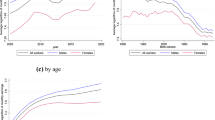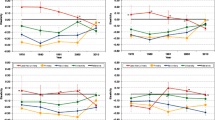Abstract
I use the cross-country and time variation in the demographic structure of 11 European countries to study how changes in cohort size affect real earnings in Europe. I find that cohort size has a negative and statistically significant effect on earnings, and that this effect is larger for the older age group—aged between 35 and 54—than for the younger group—aged 20 to 34. I also find that earnings are more sensible to changes in cohort size in Southern Europe, which points to a lower degree of substitutability between individuals with the same education but different age. I argue that the uncovered lower substitutability in the Olive Belt of Europe is in line with the higher employment protection that its workers enjoy, at least compared to the workers located in Northern Europe.




Similar content being viewed by others
Notes
See Bertola et al. (2002). Differences in flexibility are associated to different institutional setups, which affect wage determination and employment adjustment.
In the empirical section, I also experiment with alternative specifications of the weights, with no relevant qualitative changes in the results.
My sample includes Germany, Denmark, Belgium, the UK, Ireland, Italy, Greece, Spain, Portugal, Austria, and Finland.
I refer the reader to the discussion in Wright (1991), for more details.
In order to compute cohort size for the 31 age groups, I use data on individuals aged 18 to 52.
AGE takes the value 0 for age 20, 1 for age 21 and 30 for age 50.
See Katz and Murphy (1992). The index measures relative changes in employment growth across industries.
The measure of relative demand shifts developed by Katz and Murphy (1992), has been extensively used in the literature on skill-biased technical change.
The F-test for the inclusion of the log of overall cohort size in the first stage regression of log cohort size on all exogenous variables is always well above 10. Results are available from the author upon request.
These results are qualitatively robust to changes in the definition of cohort size which extends the number of adjacent ages to three and adapts the inverse V weights consequently (see Table 7 in the Appendix). They are also robust to changes in the definition of the sample, which excludes both part-timers and public sector employees (see Table 6 in the Appendix).
Notice however that the difference between the estimated coefficients (0.175 and 0.070) is not statistically significant, as the 5% confidence intervals partially overlap.
The assumption that the parameters in the CES sub-aggregates depends on regulation is not new. Blanchard and Giavazzi (2003), use a similar idea to model the effects of product market deregulation on wages and employment.
When evaluated at the sample average, EP is equal to 1.
References
Ahn Izquierdo J, Jimeno J (2000) Youth cohort size and unemployment in Spain: an exploration of national, regional and micro data. FEDEA, Mimeo
Bassanini A, Brunello G (2008) Is training more frequent when wage compression is higher? Evidence from the European community household panel. Labour Econ 15(2):272–290
Bertola G, Blau F, Kahn L (2002) Comparative analysis of labor market outcomes: lessons for the US from international long run evidence. In: Krueger A, Solow R (eds) The roaring nineties: can full employment be sustained? Sage, New York
Bertola G, Blau F, Kahn L (2007) Labor market institutions and demographic employment patterns. J Popul Econ 20(4):833–867
Berger M (1985) The effect of cohort size on earnings growth: a re-examination of the evidence. J Polit Econ 93(3):561–571
Blanchard O, Giavazzi F (2003) Macroeconomic effects of regulation and deregulation in goods and labor markets. Q J Econ 118(3):879–907
Boersch Supan A (2001) Labor market effects of population aging. NBER working paper no 8640
Card D, Lemieux T (2001) Can falling supply explain the rising return to college for younger men? A cohort based analysis. Q J Econ 116(1):705–745
European Commission (2003) The European labour market in the light of demographic change. Brussels
Jimeno J, Palenzuela D (2002) Youth unemployment in the OECD: demographic shifts, labor market institutions and macroeconomic shocks. FEDEA working paper
Johnson P, Zimmermann K (1993) Labour markets in an ageing Europe. Cambridge University Press, Cambridge
Katz L, Murphy K (1992) Changes in relative wages, 1963–1987: supply and demand factors. Q J Econ 107(1):35–78
Korenman S, Neumark D (2000) Cohort crowding and youth labor markets: a cross-sectional analysis. In: Blanchflower D, Freeman R (eds) Youth employment and joblessness in advanced countries. NBER Chicago University Press, Chicago
Layard R, Nickell S (1999) Labour market institutions and economic performance. In: Card D, Ashenfelter O (eds) Handbook of labor economics, vol 3. North Holland, Amsterdam
Lindbeck A, Snower D (1988) The insider–outsider theory of employment and unemployment. MIT Press, Cambridge MA
Nickell S, Nunziata L (2000) Labor market institutions database, center for economics performance. London School of Economics
OECD (1998) The employment outlook. OECD, Paris
Peracchi F (2002) The European community household panel: a review. Empir Econ 27(1):63–90
Shimer R (2001) The impact of young workers on the aggregate labor market. Q J Econ 116(3):969–1007
Stapleton D, Young D (1988) Educational attainment and cohort size. J Labor Econ 6(2):330–361
Welch F (1979) Effects of cohort size on earnings: the baby boom babies’ financial bust. J Polit Econ 87(4):S65–S98
Wright R (1991) Cohort size and earnings in Great Britain. J Popul Econ 4(4):295–305
Acknowledgements
This is a substantial revision of the paper entitled “Are Wages in Southern Europe more Flexible? The Effects of Cohort Size on European Earnings”, written joint with Charlotte Lauer, and produced within the TSER EDWIN Project, funded by the European Commission. I am grateful to Christian Dustmann, three anonymous referees, Charlotte Lauer, Thomas Zwick, and to the audiences at the EDWIN meetings in Milan and Mannheim for comments and suggestions. The European Community Household Panel data used in this paper are from the December 2003 release (contract 14/99 with the Department of Economics, University of Padova). The usual disclaimer applies.
Author information
Authors and Affiliations
Corresponding author
Additional information
Responsible editor: Christian Dustmann
Appendix
Appendix
Rights and permissions
About this article
Cite this article
Brunello, G. The effects of cohort size on European earnings. J Popul Econ 23, 273–290 (2010). https://doi.org/10.1007/s00148-009-0250-y
Received:
Accepted:
Published:
Issue Date:
DOI: https://doi.org/10.1007/s00148-009-0250-y




